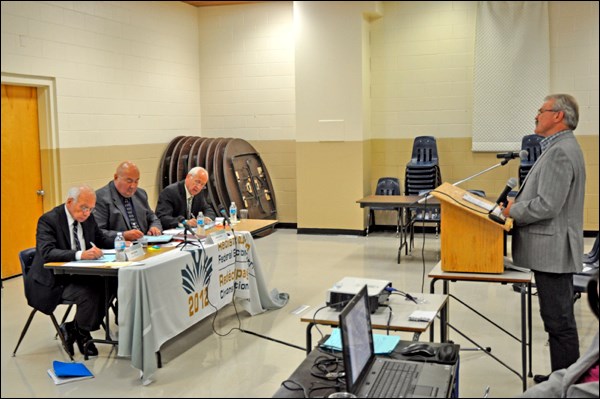Battlefords-Lloydminster MP Gerry Ritz was one of the presenters as the federal Electoral Boundaries Commission made their latest stop in North Battleford.
The commission for Saskatchewan, chaired by Justice Ron Mills alongside commission members John Courtney and David Marit, held a hearing at Don Ross Centre Tuesday.
Discussed was the impact of proposed boundary changes to the 14 electoral boundaries in Saskatchewan including Battlefords-Lloydminster. Under the proposed changes, the existing riding would essentially see the southern Kindersley portion carved off (to become part of the new riding of Kindersley-Rosetown-Humboldt), while an eastern portion extending to Rosthern would be added to create the riding of Lloydminster-Battlefords-Rosthern.
In his presentation, Ritz expressed concern about the extent of changes being proposed and suggested incremental changes to the boundaries were preferable to wholesale changes.
Ritz and some other presenters made the point they wanted trading patterns and traffic flows to be reflected in determining the boundaries. Ritz has said in his riding those flows run north-south as opposed to east-west. He elaborated on that further when he spoke to reporters Monday, prior to the hearings.
"They're taking me east into bedroom communities of Saskatoon which have certainly different wants and aspirations," said Ritz. "Those traffic flows go to Saskatoon, not this way. The oil patch is not there."
He also expressed concern about the removal of the southern portion of the riding and the impact on traffic flows there.
"They're taking off the south end right at Unity, and there are a lot of people from south of there that come into Unity as part of their school or business or whatever. My concern is when I serve that area and they cut it off arbitrarily like that, and I mail to a postal code - how do they adjust to that."
Regardless of the final composition of the electoral map, Ritz told reporters Monday he would be willing to serve whatever area the commission decided.
"I'm fine representing any part of Saskatchewan they want me to," said Ritz, but he reiterated he saw no reason to change what had already been in place for years. "We've had this system since the sixties, I don't see the need to play with it today."
In addition to the concerns about trading patterns, there was some opposition expressed to the creation of strictly urban-only ridings in Saskatoon and Regina, to replace the mixed urban-rural ridings in place there now. One individual at the hearing also voiced concern about the impact of proposed boundary changes on Shellbrook and area.
However, in his submission to the commission, former Battlefords-Lloydminster NDP candidate Glenn Tait indicated he was largely supportive of making changes.
It was "long past time boundaries were recalculated," Tait said at the hearing. He also dismissed the argument made by Ritz and others that trading patterns should be considered in setting boundaries.
Tait told the commission that at the federal level trading patterns had "no importance in boundaries." He also made the point rural MPs would still need to serve a large area regardless of the boundaries.

.png;w=120;h=80;mode=crop)


